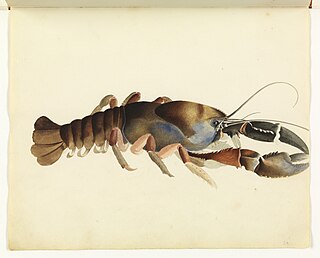Engaeus is a genus of freshwater crayfish found in Australia, the burrowing crayfishes. Fifteen of the 35 species in the genus occur in Tasmania, where they are known as the Tasmanian land crayfishes. The behaviour of these crayfish is notable as they live in burrows and construct large "chimneys" at the opening.
Engaeus australis, the lilly pilly burrowing crayfish, is a species of crayfish in the family Parastacidae. It is endemic to Australia. Engaeus australis is in the Near-threatened status in the International Union for Conservation of Nature(IUCN)'s List.
Engaeus curvisuturus is a species of crayfish in the family Parastacidae. It is endemic to the Yarra Ranges region of Victoria, Australia.
Engaeus disjuncticus is a species of crayfish in the family Parastacidae. It is endemic to Australia.
Engaeus granulatus, the central north burrowing crayfish, is a species of crayfish in the family Parastacidae. It is endemic to Australia.
Engaeus mallacoota, the Mallacoota burrowing crayfish, is a species of crayfish in the family Parastacidae. It is endemic to Australia.
Engaeus martigener, the Furneaux burrowing crayfish, is a species of crayfish in the family Parastacidae, endemic to Australia.
Engaeus orramakunna, the Mount Arthur burrowing crayfish, is a species of crayfish in the family Parastacidae. It is endemic to Australia.
Engaeus phyllocercus, the Narracan burrowing crayfish, is a species of crayfish in the family Parastacidae. It is endemic to Australia.
Engaeus rostrogaleatus, the Strzelecki burrowing crayfish, is a species of crayfish in the family Parastacidae. It is endemic to Australia.
Engaeus spinicaudatus, the Scottsdale burrowing crayfish, is a species of crayfish in the family Parastacidae. This species is only found in Tasmania, Australia. It is a medium-size burrowing crayfish with an adult carapace length of about 25 millimeters. It usually brown or purplish in color. The species is primarily found in wet buttongrass and healthy plains, but also occurs in surface seepages, floodplains of creeks and wet areas converted to pasture.
Engaeus sternalis, the Warragul burrowing crayfish, is a species of crayfish in the family Parastacidae. It is endemic to Australia. It is only known from locations on the Labertuche Creek and Wattle Creek in west Gippsland. It is a cryptic, burrowing species with a very limited distribution, and virtually nothing is known about its ecology, population dynamics or habitat requirements.
The Dandenong Burrowing Crayfish(Engaeus urostrictus) is an Australian freshwater crustacean in the Parastacidae family. As its common name suggests, the Dandenong Burrowing Crayfish is found in the Dandenong Ranges east of Melbourne, Australia.
Engaeus affinis is a species of crayfish in the family Parastacidae. It is endemic to Australia.
Engaeus karnanga is a species of crayfish in the family Parastacidae. It is endemic to Australia.
Engaeus laevis is a species of crayfish in the family Parastacidae. It is endemic to Australia.
Engaeus yabbimunna, the Burnie burrowing crayfish, is a species of crayfish in the family Parastacidae. It is endemic to Australia.
Engaeus victoriensis is a species of crayfish in the family Parastacidae. It is endemic to Australia.

Astacopsis is a genus of crayfish endemic to the island of Tasmania. There are three extant species, Astacopsis gouldi, Astacopsis franklinii, and Astacopsis tricornis. All are threatened by illegal harvesting, and A. gouldi is protected by law. A. franklinii is found in the eastern half of the island, with A. tricornis taking its place in the west. A. gouldi is found only in rivers draining into the Bass Strait, except for the Tamar River.
Furneaux is an interim Australian bioregion that comprises the Furneaux Group of more than one hundred islands off the northeast coast of Tasmania, Australia comprising 537,543 hectares.
This page is based on this
Wikipedia article Text is available under the
CC BY-SA 4.0 license; additional terms may apply.
Images, videos and audio are available under their respective licenses.

